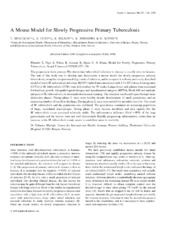A Mouse Model for Slowly Progressive Primary Tuberculosis
Journal article
Permanent lenke
https://hdl.handle.net/1956/2139Utgivelsesdato
1999-08Metadata
Vis full innførselSamlinger
Originalversjon
https://doi.org/10.1046/j.1365-3083.1999.00596.xSammendrag
The progression from primary Mycobacterium tuberculosis infection to disease is usually slow in humans. The aim of this study was to develop and characterize a mouse model for slowly progressive primary tuberculosis, using the intraperitoneal (i.p.) route of infection, and to compare it with our previously described model of latent M. tuberculosis infection. B6D2F1 hybrid mice inoculated with 1.5 × 106 colony-forming units (CFUs) of M. tuberculosis H37Rv were followed-up for 70 weeks. Lungs, livers and spleens were examined for bacillary growth, histopathological changes and mycobacterial antigens (MPT64, ManLAM and multiple antigens of M. tuberculosis), by immunohistochemical staining. The infection was found to pass through three distinctive phases. During phase 1, mice were healthy despite development of small granulomas and an increasing number of bacilli in the lungs. During phase 2, mice were unwell but mortality was low. The count of M. tuberculosis and the granuloma size stabilized. The granulomas contained an increasing population of large, vacuolated macrophages. During phase 3, mice became moribund and died rapidly, but the M. tuberculosis count remained relatively stable. The inflammatory infiltrates filled ≈ 80% of the lung parenchyma and the lesions were not well demarcated. Rapidly progressing inflammation, rather than an increase in the M. tuberculosis count, seems to contribute more to mortality.
